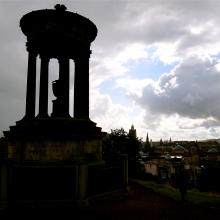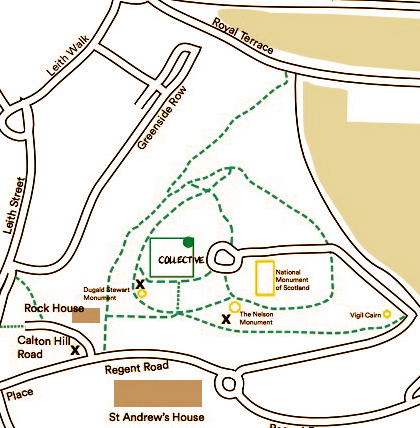
RHYS FULLERTON REVIEWS TRIS VONNA-MICHELL’S THE ARTIST AND THE GRAVEDIGGER: AFTER D.O. HILL.
‘The photograph is a grave for the living dead. It tells their history – a history of ghosts and shadows’ (Eduardo Cadavo).
On a wet Saturday morning, armed with my iPod and a waterproof jacket, I headed up Calton Hill for one of Collective’s contributions to the Edinburgh Art Festival. The piece – The Artist and The Gravedigger: after D.O. Hill by Tris Vonna-Michell (nominated for the 2014 Turner Prize) – is part of the Observers’ Walks series, a 17-minute downloadable audio guide, made specifically to be listened to on Calton Hill.
The piece is described as a tension between lived experience and historical accounts. It has two audio strands mixed together: one is a walking tour of St Andrew’s House and the other is the artist reading extracts from Eduardo Cadava's book Words of Light: Theses on the Photography of History (1998).

I’m not usually a fan of audio guides in museums and art galleries; I find that headphones make it a lonely experience and I want to experience the works for myself. Although visiting a gallery is mostly a solitary practice, with headphones on you don’t get to hear the gallery sounds, be they silence or muffled voices and footsteps. For this particular piece you don't have a choice – the only way to experience it is with headphones on, so you must shut out any external sounds and listen to the audio.
At one point, the guide describes how Calton Hill used to be a place for thousands of people to come and watch executions; you can’t help but think, at the start of the Edinburgh Festival, that thousands of people now come to watch performances of a different kind.
It’s difficult to say why I found this piece so appealing. Perhaps the excitement of the start of the Festival made me more open than usual to a different kind of contemporary art piece, or perhaps I really did find the experience immensely absorbing. I’ve been to Calton Hill many times, it’s one of my favourite places in Edinburgh. But I was forced to imagine it from a different angle, an angle that you won’t see and that’s the point – there’s a past on this hill and there’s also a future.
There is more of a history to Calton Hill than I know about, and when it is combined with words, art, photography, philosophy and the landscape, it makes you want to dig deeper and find out more. I thoroughly recommend that you experience it for yourself.
The audio work can be downloaded from the Collective website or borrowed from the gallery. Opening hours 10am–6pm (Monday–Sunday until 31 August).